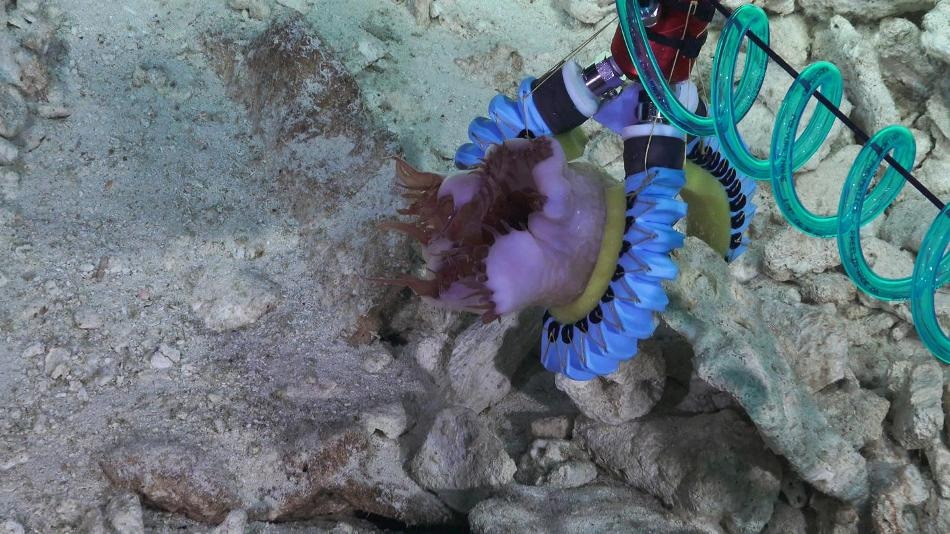Aug 3 2018
Although the airless and cold deep sea is not inhabitable for humans, it is filled with frail organisms that flourish in its harsh environment. Investigating those organisms necessitates specialized equipment equipped on a remotely operated vehicle (ROV); any other kind of equipment could in fact crack under pressure.
 A three-finger soft manipulator grasping a sea anemone attached to a rock on a hard substrate. (Image credit: Schmidt Ocean Institute)
A three-finger soft manipulator grasping a sea anemone attached to a rock on a hard substrate. (Image credit: Schmidt Ocean Institute)
A multidisciplinary team of marine biologists, engineers, and roboticists have created a sampling device that is flexible, soft, and customizable, which enables researchers to gently gather distinctive types of organisms from the sea without any harm. It also enables performing 3D-print modifications on the device overnight without any need to return to a land-based laboratory. A forthcoming paper in PLoS One digs deeper into this research.
The “soft gripper” devices designed by the researchers are equipped with two to five “fingers” made of polyurethane and other spongy materials that open and close through a low-pressure hydraulic pump system that uses seawater to propel their movement. “Many of the animals we encounter in the deep-sea are new species and these soft robots allow us to delicately interact and study a more diverse suite of fauna,” stated co-author David Gruber, Presidential Professor of Biology and Environmental Science at the City University of New York’s Baruch College. The grippers are fixed to a wooden ball that is grasped and manipulated with the help of the hard claw-like tools of an ROV’, controlled by a human operator on the ship to which the ROV is fastened.
The researchers put the most recent version of their soft grippers to test on a voyage aboard R/V Falkor in the remote Phoenix Islands Protected Area in the South Pacific. In such an isolated environment, obtaining the new parts for the grippers would be almost impossible, hence the team brought two 3D printers for developing new components on-the-fly. “By 3D printing at sea, we can innovate, on-the-fly, and come up with soft robotics to interact with soft and delicate animals that were previously unexamined—as they were too fragile,” stated Gruber, who is also a 2017–2018 Radcliffe Fellow and National Geographic Explorer.
“Being on a ship for a month meant that we had to be able to make anything we needed, and it turns out that the 3D printers worked really well for doing that on the boat. We had them running almost 24/7, and we were able to take feedback from the ROV operators about their experience using the soft grippers and make new versions overnight to address any problems,” stated Daniel Vogt, a Research Engineer at the Wyss Institute.
The soft grippers had the ability to gather sea sponges, corals, slugs, and other marine life in a considerably effective manner and with less harm compared to conventional underwater sampling tools. Using the input from the ROV operators, the researchers 3D-printed “fingernail” extensions that could be added to the fingers of the gripper to assist them in reaching below the samples that were resting on hard surfaces. Each finger was also equipped with a flexible mesh that assists in keeping the samples within the fingers’ grip. One more two-fingered version of the grippers was also developed based on the familiarity of the ROV pilots in controlling the existing two-fingered graspers, and their request that the two fingers be able to grasp samples with a “pinch” grasp (for small objects) as well as a “power” grasp (for large objects).
The researchers are attempting to further develop the grippers, looking to add sensors with the ability to indicate to the ROV operator when the grippers come into contact with an organism, “feel” how hard or soft it is, and take other measurements. Their ultimate aim is to be in a position to capture sea creatures in the deep ocean and acquire complete physical and genetic data without removing them out of their native habitats.
The National Oceanographic and Atmospheric Association, the Schmidt Ocean Institute, the National Science Foundation, the National Academy of Sciences, the PIPA Conservation Trust, the PIPA Scientific Committee, and the Wyss Institute at Harvard University supported this study.